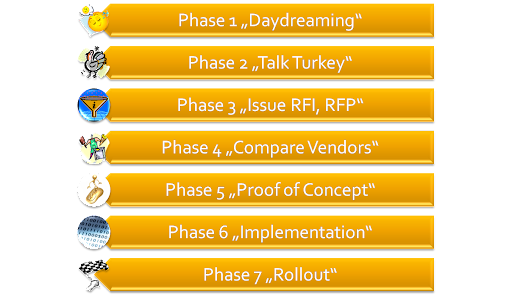Here are my thoughts about vendor selection process and implementation phases - any comments highly appreciated!

Phase 1 „Daydreaming“
Phase 2 „Talk Turkey“
Phase 3 „Issue RFI, RFP“
Phase 4 „Compare Vendors“
Phase 5 „Proof of Concept“
Phase 6 „Implementation“
Phase 7 „Rollout“

Phase 1 „Daydreaming“
- Determine Business Needs
- What are the challenges?
- What was the initial reason to think about a new CRM strategy?
- Get help from an external advisor if necessary.
- Define the ideal CRM solution
- Outline the Hi-Level requirements
- See the company from a customers‘ perspective
Phase 2 „Talk Turkey“
- Come back to reality – you can not archieve everything you wish (what about ROI?)
- Sync with existing CRM strategy and business processes – approve a project
- Priotize the wishlist – separate the crtitical points from the nice-to-haves
- Discuss with customers, employees and advisors
- Identify the technology to be used (i.e. SaaS)
Phase 3 „Issue RFI, RFP“
- Create a list of required functionality
- Send this list to anumber of vendors (4-8)
- Find a rating scheme and qualify the returned answeres
- Ask the vendors to create a proposed solution
- Asses and compare the outlined solutions
- Find the two (or three) best fitting vendors
- Focus on the vendor rather than the product
- Technology must fit the strategy!
Phase 4 „Compare Vendors“
- Does the corparate culture fit?
- Is the vendor financial stable and is the roadmap promising and complete?
- Is the product future proof (technology, platform), can it grow with your company?
- Pricing model and license cost
- Cost of implementation and customization
- Required Hardware
Phase 5 „Proof of Concept“
- Find a business process that covers as much technical aspects as possibe but can be implemented within a three week timeframe
- Ask vendors to implement this business process with their product on site
- Have IT and business people supervise the customization and administration process – get their buy-in!
- Finish with a workshop where the vendor presents the PoC and answers questions how it was done
- Try to estimate the efforts for the full project
Phase 6 „Implementation“
- Keep business involved - gather feedback from future users during the implementation phase
- Create reusable application code
- Keep future upgrades in mind
- Involve customers as beta-testers
- Favor a staged approach for a ‚big bang‘
Phase 7 „Rollout“
- Let users decide, not the contract – usability is the most critical factor...
- Design DOES matter!
- Provide detailed information to users (employees and customers)
- Training
- Collect feedback and keep improving the functionality and business processes



Forgot an important point: Expectation setting and success criteria!
ReplyDeleteThe most CRM implementations fail because of fuzzy and not well defined success criteria...